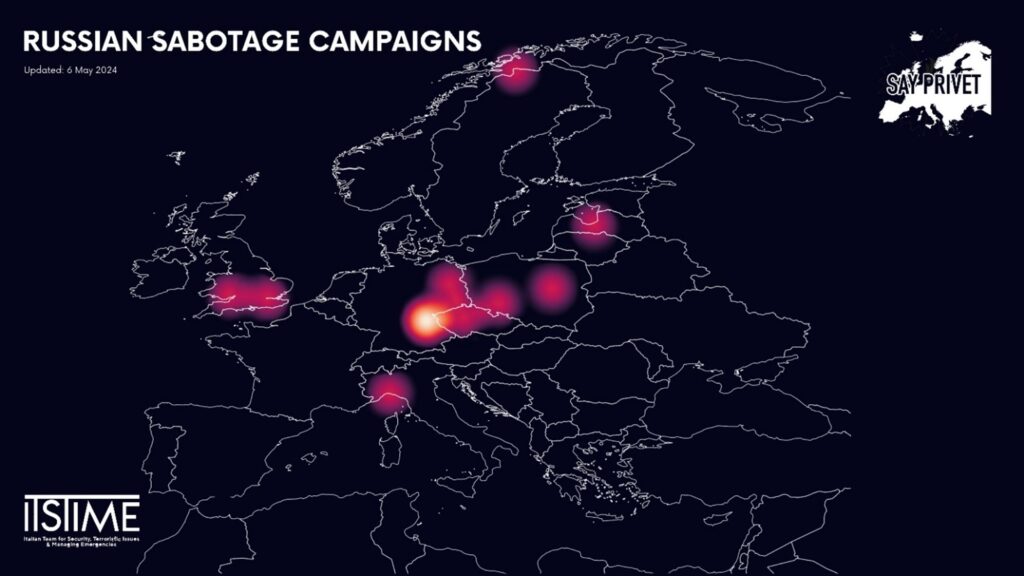Since February 2024, at least ten operations between arson attacks and train sabotage have been planned, several of which have been intercepted by the intelligence services of the countries targeted. Where operations were successful, pictures and related videos were disseminated on PMC Wagner’s main Telegram channels. Such acts of sabotage do not constitute an isolated case, but rather part of a broader operation.
On 12 February 2024, marking two years since Ukraine was invaded and a decade since the establishment of PMC Wagner, an official Wagner channel launched a recruitment campaign. This campaign aims to enlist individuals willing to undertake “special duties in enemy territory”. Practically, it consists of a call to action to perform sabotage operations on European soil through arson attacks against sensitive civilian and military targets – such as IT companies, places of worship, and museums. In some states, including Italy, the campaign expanded to promoting the organisation of anti-NATO and anti-EU demonstrations in specific national anti-system Telegram groups.

Initially, Eastern European countries were the main target to which recruits were addressed. Yet, over a few weeks, the campaign spread to the entire European continent. On 20 April 2024, one of PMC Wagner’s main channels published a French-language post in which “due to the international situation” databases of the French army, law enforcement and intelligence services, as well as the inhabitants of France, were demanded in exchange for financial compensation. A clear response to President Emmanuel Macron’s statements alluding to a French intervention in the Russo-Ukrainian war in case of the downfall of Kyiv. Furthermore, through the spatial analysis of operations and demonstrations (potentially led by Russia), a significant concentration of such operations emerges in Central and Eastern Europe, particularly in Germany and Poland. Not a coincidence. While Poland is the main NATO partner overlooking the Russian-Ukrainian front lines, Germany stands out among European countries regarding the number and quantity of armaments and defence systems supplied to Ukraine (second only to the US). Moreover, in concert with France, Warsaw and Berlin are Kyiv’s main European allies.
A new front of the Russo-Ukrainian war has largely opened on European soil, necessitating vigilant monitoring. The attacks, which have more communicative than physical impacts, serve as a method for Russia to intervene in Europe without directly engaging in military confrontation. By employing urban guerrilla techniques to strike European territory during a period of heightened tension in the ongoing conflict, Russia aims to amplify fear among the public. This strategy seeks to fracture the cohesion among European leaders further, exploiting the atmosphere of fear to manipulate political and social dynamics on the continent.
Furthermore, this campaign can form a breeding ground for pro-Russian subversive groups or fighters returning from the Russian-Ukrainian front, especially since pervasive disinformation campaigns flank it. Such cases occurred in France and Germany. The Direction Générale de la Sécurité Extérieure (DGSE, French intelligence service) has for some time been closely monitoring fighters returning from the Russian-Ukrainian front, as the case of Mickael Takahashi demonstrates. Similar to the DGSE, the security services in Berlin had been targeting Deter S., a former fighter in the Donbas conflict (2014), who was arrested in April 2024 on charges of being in communication with the GRU (the Russian military intelligence agency) to plan acts of sabotage on German territory. De facto, these are individuals accustomed to violence and with strong ideological affinities to the Russian campaigns, who can thus continue to fight in other forms. This is the reason why they are an ideal target audience for recruitment campaigns for carrying out similar sabotage or information exfiltration activities, such as the one organised by PMC Wagner.

